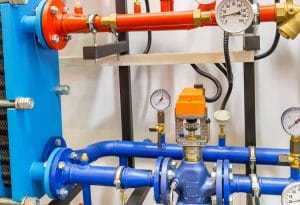 With the introduction of heat exchangers, companies had new options for meeting their electrical thermal management needs. Rather than having to depend on solutions such as air conditioners or air compression units, they could now benefit from more streamlined methods of cooling their electrical enclosures and control cabinets. As heat exchangers and other forms of technology continued to advance, companies have benefited from an even variety of options. Thanks to multiple, sometimes specialized iterations of modern heat exchangers, companies in every industry can translate their highly efficient and eco-friendly thermal management processes into an increasingly wider range of applications.
With the introduction of heat exchangers, companies had new options for meeting their electrical thermal management needs. Rather than having to depend on solutions such as air conditioners or air compression units, they could now benefit from more streamlined methods of cooling their electrical enclosures and control cabinets. As heat exchangers and other forms of technology continued to advance, companies have benefited from an even variety of options. Thanks to multiple, sometimes specialized iterations of modern heat exchangers, companies in every industry can translate their highly efficient and eco-friendly thermal management processes into an increasingly wider range of applications.
Advanced heat pipes
One of the more traditional forms of heat exchangers are heat pipes, which are metal pipes that are lined with a capillary wicking material that holds moisture evenly throughout the pipe. An eco-friendly cooling fluid flows through the pipes and absorbs waste heat that is emitted by electrical components. Once it absorbs enough heat, the fluid evaporates, becoming less dense and flowing to a cooler area where it can release the heat, all while effectively controlling the temperature inside of the electrical enclosure. Modern heat pipes can be custom-made to bend, fold, and lay flat as necessary to fit any given application’s parameters.
Custom-designed cold plates
Along with advanced heat pipes, custom-designed cold plates are also a popular form of heat exchanger used by companies in virtually all industries. Cold plates are also designed to allow an eco-friendly cooling fluid to flow freely through them and transfer waste heat at rapid paces. They do so through paths that are carefully custom-machined into the metal cold plates, which can be stacked together to optimize thermal management in tight spaces. Their versatility makes cold plate heat exchangers a preferred option for a wide range of applications, allowing them to bring the benefits of high-performance liquid cooling to companies at a lower cost.
How to choose the right heat exchanger
Today’s heat exchangers are designed to not only streamline electrical thermal management, but to create efficient and highly reliable solutions for thermal management needs of all kinds. Heat pipes and cold plates can be customized to meet most application’s parameters, and the principles of transferring heat that they rely on can also be used for more specialized processes. For example, in the molding industry, thermal pins use heat exchanger technology to rapidly remove heat from molds. In technologically advanced industries, such as military and aerospace, heat exchangers can serve as the foundation for cooling high-performance, ruggedized technologies.
For more information about different types of heat exchangers and other custom thermal solutions, call Noren Thermal Solutions in Taylor, TX, at 866-936-6736.







